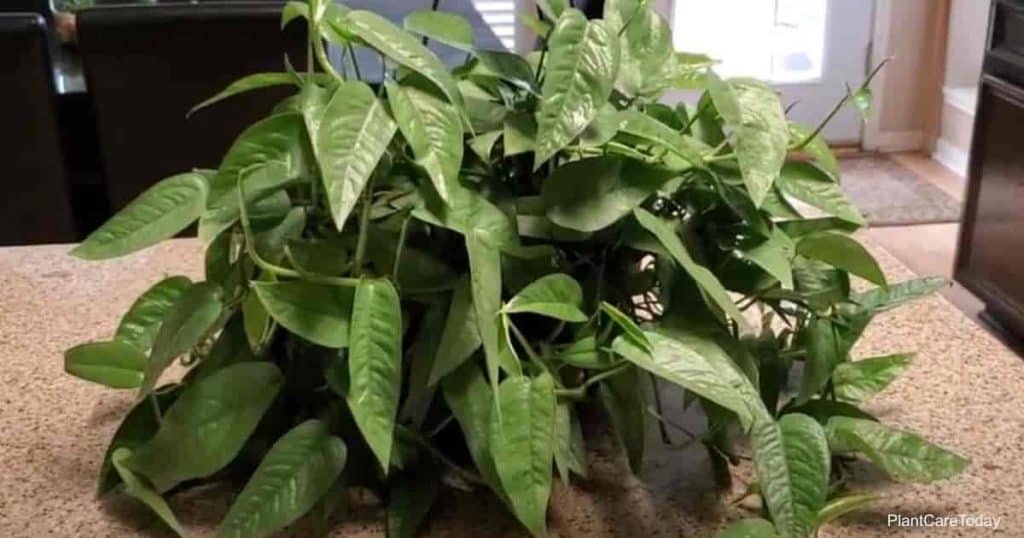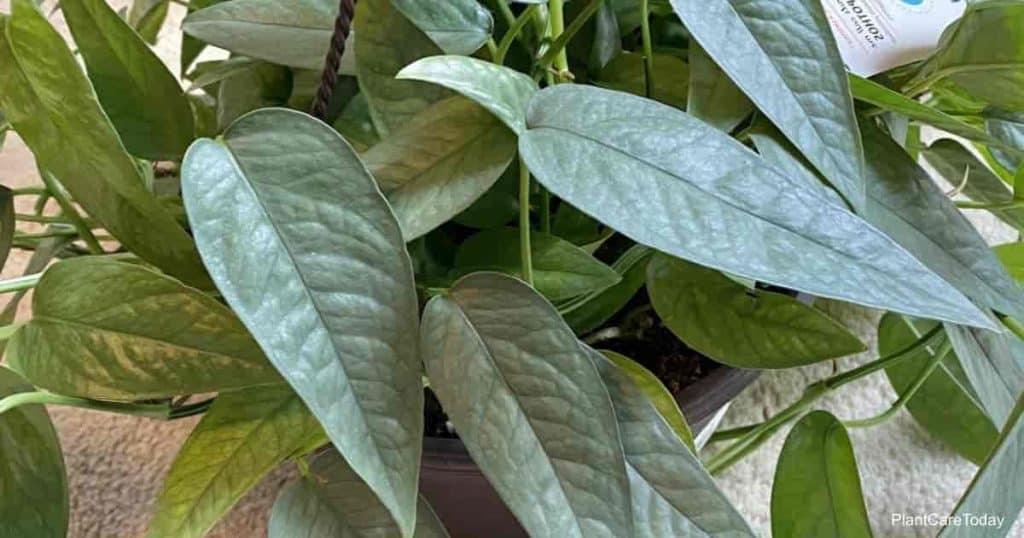Cebu Blue Pothos aka Epipremnum pinnatum (ep-ih-PREM-num pin-NAY-tum) is an interesting Pothos variety. It features shiny, silver/blue leaves that exhibit a slight sheen under just the right light.

This evergreen perennial vine is a member of the Araceae family and the Epipremnum genus. It hails from the Philippines on the isle of Cebu, hence its most common name.
Cebu Blue also goes by a few other common names, including:
- Philodendron Cebu Blue
- European House Plant
- Scindapsus Aureum
- Centipede Tongavine
- Blue Pothos
- Dragon-tail
- Devil’s Ivy
Besides the Cebu Island, Blue Pothos grows in northern Australia, several parts of Asia, and some European settings.
Cebu Blue Pothos Care
Size, Growth & Foliage Characteristics
This climbing, vining plant will grow as long/tall as it is able. In its natural setting, Scindapsus Aureum can grow to be 40′ feet high.
When kept as a houseplant, it usually tops out at about four feet. Pruning and training keeps the plant in control.
The plants’ growth habit includes two distinct phases, juvenile and mature. Its appearance is quite different in each stage of growth.
In the juvenile phase, Cebu Blue Pothos has green, blue-green, blue-gray, and/or silvery-blue leaves. A healthy plant may display a lively mix of all these colors. Ample lighting encourages more vivid coloration.
The leaves can be either oval or elongated and usually grow to be two, three, or four inches long. These young, pretty plants are an ideal choice for a hanging basket in a bright window.
When the Blue Pothos reaches the mature stage, the leaves become greener and develop a zigzagging division at the leaves’ ends. This pattern makes them resemble palm fronds. Mature leaves will reliably reach a length of four inches.
Whereas juvenile plants do well dangling in a hanging basket. Mature plants are vigorous climbers needing the support of a trellis, totem, or moss pole.
If kept outdoors in a conducive climate, the leaves of blue pothos will grow much bigger than four inches.
More on Caring For Pothos Plants & Scindapsus Pictus
Flowering & Fragrance
Pothos Cebu Blue is grown as a houseplant for its foliage. When growing wild in its natural habitat, it will flower, but this is rare among houseplants.
Flowers are unremarkable, consisting of an erect, cylindrical, yellow structure open on one side. Flowers transition into non-edible berries, which each contain one or two seeds. [source]
Light & Temperature
Blue Pothos likes bright, indirect light for the best coloration and growth. It can do well in a low light setting because it is a woodland plant. If you keep the plant under grow-lights, remember to give it at least 8 hours rest in darkness every 24 hours.
Protect the plant from bright, direct sunlight as this can scorch its leaves. Pay close attention to changes in lighting with the seasons change.
If your plant is getting too much direct sunlight, move it or add a sheer curtain to protect it. Morning sunlight is preferable to midday and afternoon sun.
The ideal room temperatures for this plant range from 60° – 80° degrees Fahrenheit. Epipremnum pinnatum is winter hardy in USDA hardiness zones 9-11.
Watering & Feeding
The Cebu Blue Pothos plant does best with the soak-and-dry method of watering. Water the plant thoroughly, allowing water to flow through the drainage holes.
Read our article on Watering Pothos Plants
Do not water again until the top inch of soil is quite dry. As with all plants, excessive watering will cause root rot.
These tropical vines like a humid setting. Place your plant on a pebble tray with a bit of water (not touching the bottom of the pot). As the water evaporates, it will increase the humidity levels around the plant.
Another option is to set up a humidifier near the plant to increase ambient humidity levels in the room.
Fertilize monthly throughout the growing season with a diluted solution of balanced liquid houseplant fertilizer. Do not fertilize during the late fall and through the winter. Reduce watering during the winter, as well.
Soil & Transplanting
Cebu Blue Pothos does well with a light, airy potting mix. A standard, bagged potting mix is fine. Improve the soil by adding some coarse material, such as sand, vermiculite, perlite, or orchid bark.
Your choice in pots will also affect how your Cebu Blue grows. If you place your young plant in a hanging basket and prune it regularly, it will stay in the juvenile phase longer. But, it will not thrive.
It’s better to move your plant to a pot with support when you notice the leaves beginning to mature and split. This support allows the plant to strengthen and reach its full indoor potential.
Grooming & Maintenance
Maintaining Cebu Blue Pothos is a pretty easy task. As long as you provide the correct combination of:
- Well-draining soil
- Good container
- Bright, indirect light
- A warm, humid location
The plant will need very little attention other than cleaning the leaves with a damp cloth.
A good soaking as needed, monthly fertilizer, and light pruning to maintain shape will do. Repot about once a year in the springtime.

How To Propagate Cebu Blue Pothos
Blue Pothos is as easy to propagate as all Pothos.
- Take healthy cuttings, a few inches long, each possessing at least two nodes.
- These are the little knots on the stem from which leaves grow.
- Place the cuttings in water or in damp soil to root.
- Make sure to cover the nodes during the rooting process.
- Roots will grow from the nodes.
- If you are rooting the plant in water
- Transfer the cuttings to moist soil when roots begin to form.
Blue Pothos propagates so easily that you can even start a plant from a single leaf and stem.
- Trim off a leaf with a good stem and node
- Pop it into water
It may not grow roots as quickly as a cutting with two nodes, but it will grow. Give the cuttings time. Change the water daily to prevent mold growth.
It is possible to keep Pothos cuttings in water for an extended time period. But, the plant will not thrive in this manner. If it stays in the water for too long, it may have difficulty transitioning to growing in soil when you transfer it.
If you start cuttings in soil, put the soil in a clear plastic container with plenty of drainage holes in the bottom or a clear plastic bag with drainage/aeration holes punched in. These methods will allow you to track root growth.
When rooting in soil, keep the soil uniformly moist. Keep the container/bag in a warm, humid location with bright, indirect sunlight.
No matter which propagation method you use, always to use a very sharp sterilized cutting tool to take cuttings.
Check out the article on Growing Pothos from Cuttings
Cebu Blue Pothos Common Pests or Diseases
Generally speaking, Pothos Cebu Blue Plants are trouble-free and easy to grow. As with all plants, improper care can lead to problems.
Watch out for these potential hazards:
- Too little water and/or too little light can cause strange shaped or yellow leaves. Give your plant at least 6 hours of bright, indirect sunlight daily. Establish a regular soak and dry watering schedule.
Details on Yellow Leaves On Pothos
- Overwatering, excessive sun exposure and/or excessive fertilizer can cause brown, crispy leaves. Remember to protect your plant from direct, afternoon sun. Water judiciously, and fertilize lightly.
- Plants weakened by improper conditions are subject to houseplant pests such as spider mites, mealy bugs, and plant scale. Generally speaking, remove these pests by:
- Pruning away damaged parts of the plants
- Washing the plant with a strong spray of water
- Following up with a spray of insecticidal soap.
Determine where your care practices have gone wrong and make adjustments as needed.
Is The Plant Considered Toxic Or Poisonous?
Blue Pothos is toxic to dogs and cats. It’s best to place it in a hanging basket, on a high shelf, or in a closed plant room where children and pets cannot access it.
Details on Are Pothos Plant Poisonous?
Contact with the plants’ sap may cause dermatitis. Ingestion of the plant may result in:
- Swelling and redness around the mouth
- Shortness of breath
- Stomach pain
- Vomiting
It’s a good idea to protect your skin and eyes when handling or pruning this plant. Be sure to wear eye protection, gloves, and long sleeves.
Is The Plant Considered Invasive?
Epipremnum pinnatum is invasive in tropical settings. The plant grows rapidly and aggressively and will grow high into the treetops. If left unchecked, it smothers native vegetation and blocks the sun from reaching plants in the understory. It is considered a Category II invasive plant in the state of Florida. [source]
Suggested Cebu Blue Pothos Uses
This easy-care plant is a great addition to your indoor plant collection. It can grow as an annual outdoors in non-tropical settings.
Because it is so hardy and so versatile, Blue Pothos makes a great hanging plant in a bright plant room. It will also do well in a standard office setting and can tolerate the low light of a bathroom setting.
If you have a bright east window that could do with a natural privacy treatment, blue pothos will happily climb up a trellis to form a natural curtain!